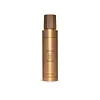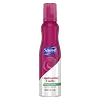What's inside
What's inside
 Key Ingredients
Key Ingredients

No key ingredients
 Benefits
Benefits

 Concerns
Concerns

 Ingredients Side-by-side
Ingredients Side-by-side

Water
Skin ConditioningPropanediol
SolventIsobutane
Propane
Glycerin
HumectantPanthenol
Skin ConditioningArginine
MaskingSerine
MaskingAlanine
MaskingGlycine
BufferingThreonine
Proline
Skin ConditioningValine
MaskingHistidine
HumectantIsoleucine
Skin ConditioningPhenylalanine
MaskingAspartic Acid
MaskingPCA
HumectantOryza Sativa Seed Protein
AntioxidantPolyquaternium-4
Polyquaternium-11
Polyquaternium-73
Oryza Sativa Extract
AbsorbentSalix Nigra Bark Extract
Skin ProtectingSodium Surfactin
CleansingHydrolyzed Pea Protein
EmollientHydrolyzed Soy Protein
HumectantCalcium Gluconate
HumectantHydrolyzed Amaranth Protein
Skin ConditioningGlyceryl Caprylate
EmollientSodium Lactate
BufferingOctyldodecyl Ricinoleate
EmollientPolyglyceryl-6 Oleate
EmulsifyingCetrimonium Chloride
AntimicrobialCaprylyl/Capryl Glucoside
CleansingSodium Cocoyl Glutamate
CleansingCocamidopropyl Betaine
CleansingButylene Glycol
HumectantPhytic Acid
Gluconolactone
Skin ConditioningTetrasodium Glutamate Diacetate
Phenoxyethanol
PreservativeEthylhexylglycerin
Skin ConditioningCitric Acid
BufferingParfum
MaskingWater, Propanediol, Isobutane, Propane, Glycerin, Panthenol, Arginine, Serine, Alanine, Glycine, Threonine, Proline, Valine, Histidine, Isoleucine, Phenylalanine, Aspartic Acid, PCA, Oryza Sativa Seed Protein, Polyquaternium-4, Polyquaternium-11, Polyquaternium-73, Oryza Sativa Extract, Salix Nigra Bark Extract, Sodium Surfactin, Hydrolyzed Pea Protein, Hydrolyzed Soy Protein, Calcium Gluconate, Hydrolyzed Amaranth Protein, Glyceryl Caprylate, Sodium Lactate, Octyldodecyl Ricinoleate, Polyglyceryl-6 Oleate, Cetrimonium Chloride, Caprylyl/Capryl Glucoside, Sodium Cocoyl Glutamate, Cocamidopropyl Betaine, Butylene Glycol, Phytic Acid, Gluconolactone, Tetrasodium Glutamate Diacetate, Phenoxyethanol, Ethylhexylglycerin, Citric Acid, Parfum
Water
Skin ConditioningHydrofluorocarbon 152a
Pvp
Emulsion StabilisingCetearyl Alcohol
EmollientDimethyl Ether
SolventStearamidopropyl Dimethylamine
EmulsifyingBehentrimonium Chloride
PreservativeParfum
MaskingDimethicone
EmollientDMDM Hydantoin
PreservativeDipropylene Glycol
HumectantLactic Acid
BufferingDisodium EDTA
Amodimethicone
Butylene Glycol
HumectantIodopropynyl Butylcarbamate
PreservativePEG-7 Propylheptyl Ether
Emulsion StabilisingCetrimonium Chloride
AntimicrobialWater, Hydrofluorocarbon 152a, Pvp, Cetearyl Alcohol, Dimethyl Ether, Stearamidopropyl Dimethylamine, Behentrimonium Chloride, Parfum, Dimethicone, DMDM Hydantoin, Dipropylene Glycol, Lactic Acid, Disodium EDTA, Amodimethicone, Butylene Glycol, Iodopropynyl Butylcarbamate, PEG-7 Propylheptyl Ether, Cetrimonium Chloride
Ingredients Explained
These ingredients are found in both products.
Ingredients higher up in an ingredient list are typically present in a larger amount.
Butylene Glycol (or BG) is used within cosmetic products for a few different reasons:
Overall, Butylene Glycol is a safe and well-rounded ingredient that works well with other ingredients.
Though this ingredient works well with most skin types, some people with sensitive skin may experience a reaction such as allergic rashes, closed comedones, or itchiness.
Learn more about Butylene GlycolThis ingredient is a preservative, antimicrobial, and emulsifier. It is often used in cosmetics for its ability to cleanse, condition, and reduce static.
Cetrimonium chloride is a quaternary ammonium salt, meaning it has a water-soluble structure.
Parfum is a catch-all term for an ingredient or more that is used to give a scent to products.
Also called "fragrance", this ingredient can be a blend of hundreds of chemicals or plant oils. This means every product with "fragrance" or "parfum" in the ingredients list is a different mixture.
For instance, Habanolide is a proprietary trade name for a specific aroma chemical. When used as a fragrance ingredient in cosmetics, most aroma chemicals fall under the broad labeling category of “FRAGRANCE” or “PARFUM” according to EU and US regulations.
The term 'parfum' or 'fragrance' is not regulated in many countries. In many cases, it is up to the brand to define this term.
For instance, many brands choose to label themselves as "fragrance-free" because they are not using synthetic fragrances. However, their products may still contain ingredients such as essential oils that are considered a fragrance by INCI standards.
One example is Calendula flower extract. Calendula is an essential oil that still imparts a scent or 'fragrance'.
Depending on the blend, the ingredients in the mixture can cause allergies and sensitivities on the skin. Some ingredients that are known EU allergens include linalool and citronellol.
Parfum can also be used to mask or cover an unpleasant scent.
The bottom line is: not all fragrances/parfum/ingredients are created equally. If you are worried about fragrances, we recommend taking a closer look at an ingredient. And of course, we always recommend speaking with a professional.
Learn more about ParfumWater. It's the most common cosmetic ingredient of all. You'll usually see it at the top of ingredient lists, meaning that it makes up the largest part of the product.
So why is it so popular? Water most often acts as a solvent - this means that it helps dissolve other ingredients into the formulation.
You'll also recognize water as that liquid we all need to stay alive. If you see this, drink a glass of water. Stay hydrated!
Learn more about Water